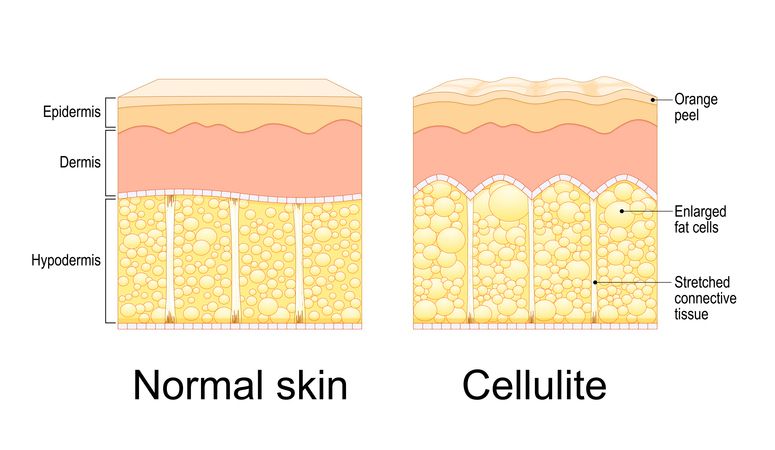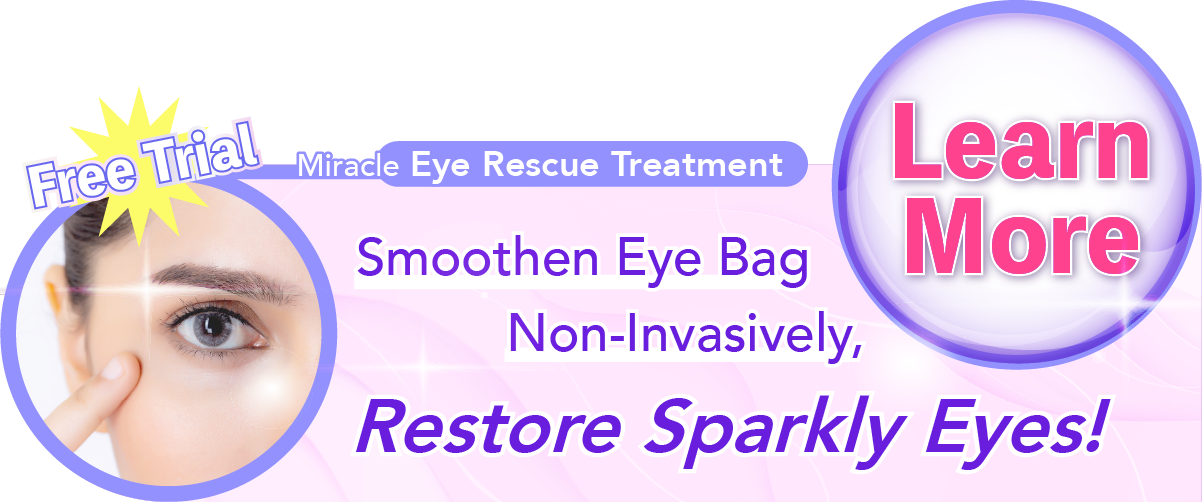
Author: Natalie Ng|Updated: 30 April 2025
If you occasionally wake up with puffy eyes, you're not alone. It can be frustrating to see swelling in the under eye area first thing in the morning. This usually happens when fluid builds up overnight, especially if you've had too much salt, cried before bed, didn’t get enough sleep, or are dealing with allergies or other symptoms. Sometimes, puffiness under the eyes can also be linked to hormonal changes, poor diet, or certain medical conditions. The skin around the eyes is delicate, and small changes in your routine can affect how it looks in the morning. While home remedies like cold compresses or chilled tea bags can help reduce swelling, persistent puffiness may need a closer look. Things like dark circles, under eye bags, or eye puffiness that stick around could point to an underlying condition—or simply the natural aging of muscles supporting the eyelids and lower eyelids. If you’re wondering what causes puffiness and what actually works to reduce it, keep reading. This guide will walk you through causes, home remedies, and when to talk to a healthcare professional about other treatments like eye creams, chemical peels, laser resurfacing, or even eyelid surgery.

Understanding Why Your Eyes Get Puffy in the Morning
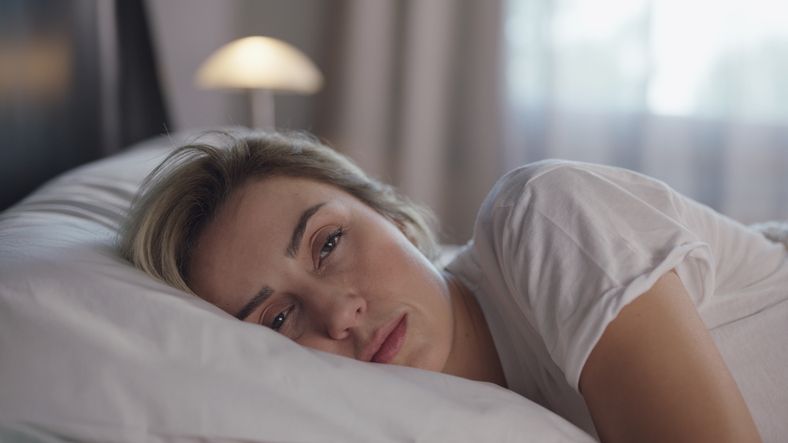
1. Lying Flat at Night Causes Fluid to Settle
When you sleep, especially if you lie flat on your back or stomach, gravity causes fluid to shift and collect in the under eye area. This buildup can make the eyes appear swollen when you wake up. Using an extra pillow to slightly raise your head can help reduce fluid retention and reduce eye puffiness.
2. Salt Intake and Fluid Retention
Eating too much salt—especially at night—can cause the body to retain water. This affects many areas of the body, including the delicate eye area. Too much salt makes puffiness under the eyes more noticeable in the morning. Reducing salt intake can help prevent this.
3. Lack of Sleep and Fatigue
Not getting enough sleep can lead to swelling and dark circles. Sleep helps regulate the body’s systems, including circulation and fluid balance. Poor sleep disrupts this balance, causing puffiness in the under eye area. A consistent sleep schedule supports younger looking eyes and helps reduce under eye bags.
4. Allergies and Irritation
Allergies are a common cause of puffy eyes. They can cause inflammation, watery eyes, and irritation. Rubbing your eyes or exposure to allergens during sleep can increase swelling and worsen symptoms in the morning.
5. Crying Before Bed
Tears contain salt. Crying before sleep can cause fluid to collect around the eyelids. This can lead to puffiness the next morning, especially if the tears were followed by lying down.
6. Aging and Weakened Eye Muscles
Over time, the muscles supporting the lower eyelids and upper eyelid weaken. Skin cells lose elasticity, and fat shifts forward, making eye bags and puffiness more visible. This process is natural but can be made worse by lack of sleep, poor diet, or other health conditions.
7. Medical Conditions and Other Symptoms
Some health conditions, such as thyroid problems or kidney issues, can cause persistent puffiness under the eyes. If the swelling doesn’t improve or is paired with other symptoms, talk to a healthcare professional. They can help you rule out a serious condition and suggest the right treatment plan.
In the next section, we’ll look at simple things you can do before 9AM to reduce eye swelling fast.

Quick At-Home Remedies for Eye Swelling
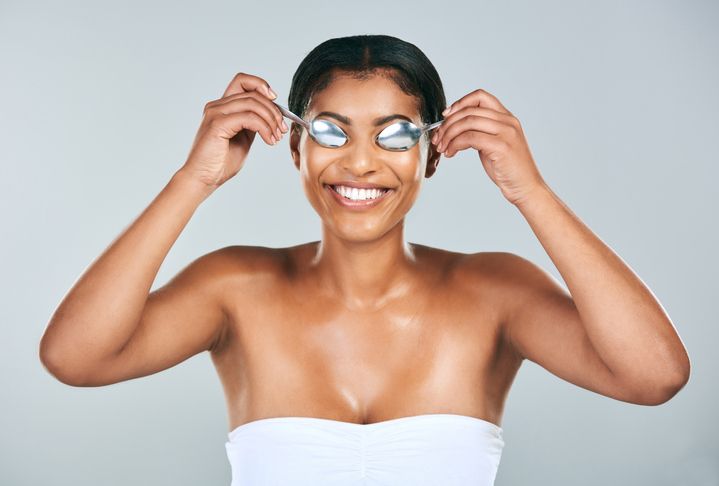
1. Cold Spoons
Time Needed: 5 minutes Place two metal spoons in the fridge or freezer for at least 10 minutes. Once chilled, press the back of each spoon gently onto the under eye area. The cold temperature helps constrict blood vessels and reduce inflammation. This is especially useful for mild puffiness under the eyes.
2. Cucumber Slices
Time Needed: 10 minutes Cut two slices of cold cucumber and place them on your eyes. Cucumbers contain antioxidants and have a cooling effect on the skin. This method helps soothe irritated skin cells and refresh the delicate eye area. It's a good option for tired or watery eyes.
3. Tea Bags
Time Needed: 15 minutes Steep two green or black tea bags, let them cool completely, then place them over closed eyelids. The caffeine helps shrink blood vessels while antioxidants reduce inflammation. This method is useful for dark circles, under eye puffiness, and irritation linked to allergies or lack of sleep.
4. Ice Pack
Time Needed: 10 minutes Wrap a few ice cubes in a clean cloth and gently apply them over the eye area. Avoid direct contact with ice to prevent skin damage. Cold compress methods like this reduce swelling quickly by tightening blood vessels and lowering fluid retention in the area.
5. Cold Water Splash
Time Needed: 2 minutes Splash your face with cold water several times, especially focusing on the eyes. This jump-starts blood flow and helps wake up the skin. It’s the fastest option for those in a rush and works well before applying an eye serum or moisturizer.
6. Gentle Massage and Extra Tools
Use your ring fingers to gently tap around the under eye area, moving from the inner corner outwards. This encourages lymphatic drainage and helps reduce eye puffiness naturally. For better results, use a cool metal roller or keep your de-puffing tool in the fridge overnight. Massage lightly to avoid stretching the thin skin around the eyes.
Adding an extra pillow while you sleep can prevent fluid from building up overnight, especially if you sleep on your back. These simple home remedies work best when used consistently and can help you manage morning puffiness without cosmetic procedures.
Read More
Book Now to Experience
Miracle Eye Rescue Treatment
1 Minute Self-Registration
Date should not be before minimal date

Preventive Steps to Avoid Morning Eye Puffiness
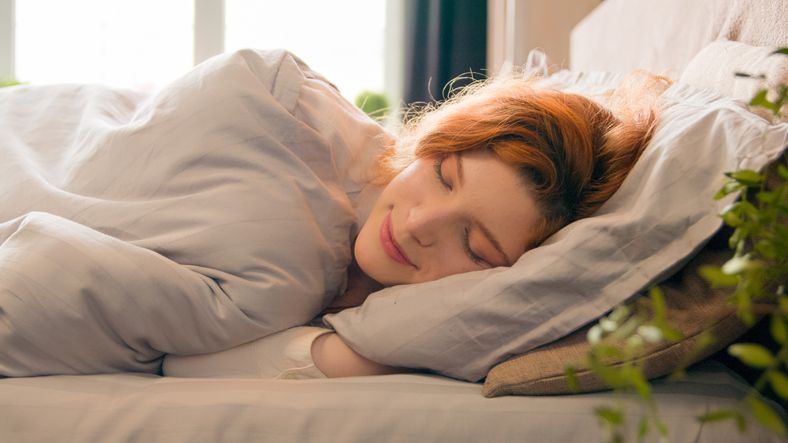
Making a few changes to your evening routine can help reduce under eye puffiness before it starts. These small habits support better fluid balance, improve skin health, and reduce swelling by morning.
1. Elevate Your Head While Sleeping
Benefit: Prevents fluid accumulation around the eyes Sleeping with your head slightly raised helps stop fluid from settling in the lower eyelids overnight. Use an extra pillow or a wedge to gently lift your head. This position uses gravity to reduce puffiness under the eyes by morning.
2. Remove Makeup Thoroughly
Benefit: Keeps pores clear and reduces irritation Leftover makeup can block pores and cause irritation in the eye area. Always remove makeup gently using a cleanser made for the delicate eye area. This prevents inflammation and reduces the chance of waking up with swollen eyelids.
3. Stay Hydrated — But Cut Off Fluids Before Bed
Benefit: Balances the body’s fluid retention Drink plenty of water throughout the day, but stop about two hours before bedtime. Staying hydrated supports healthy skin cells and helps reduce fluid retention. Avoid drinking too much water right before sleep, as this can cause puffiness by morning.
4. Avoid Salty Foods Before Bed
Benefit: Reduces water retention and swelling Too much salt in your evening meal can lead to puffiness under the eyes the next day. Salty foods increase fluid buildup and worsen under eye bags. Limiting salt intake at night helps the body maintain a better balance.
5. Use a Hypoallergenic Pillowcase
Benefit: Minimizes irritation for allergy-prone skin Pillowcases can trap allergens like dust and pollen. A hypoallergenic pillowcase helps reduce irritation and swelling around the eyes. Wash pillowcases regularly to avoid buildup that can trigger skin conditions or eye puffiness.
6. Take Allergy Medication Before Bed (if needed)
Benefit: Prevents overnight allergic reactions If you have seasonal allergies, taking your antihistamine at night can help control symptoms while you sleep. This reduces watery eyes, inflammation, and swelling in the morning.

When to Seek Medical Help for Swollen Eyes

Most people deal with puffy eyes from time to time, and it usually isn't a cause for concern. But in some cases, swelling in the under eye area may point to something more serious. Knowing when to get help from a healthcare professional can protect your vision and your overall health.
Swelling That Doesn’t Go Away
Symptoms: Puffiness that stays for more than a few days If under eye puffiness or swelling doesn’t improve with home remedies or lifestyle changes, it may not be caused by lack of sleep or fluid retention alone. Persistent puffiness can be a sign of an underlying condition, such as thyroid disease, kidney issues, or a skin condition that requires medical treatment.
Pain, Redness, or Light Sensitivity
Symptoms: Discomfort, especially if it’s getting worse Swelling that comes with sharp pain, redness, or light sensitivity may point to an infection or a more serious condition like orbital cellulitis. These symptoms should not be ignored. Seek medical attention right away to avoid complications.
Vision Changes
Symptoms: Blurred vision, double vision, or trouble focusing If swelling around your eyes comes with any kind of vision problem, it could affect the muscles supporting your eyes or the blood vessels behind them. These symptoms could be linked to inflammation or pressure buildup and should be checked by a healthcare provider.
Swelling That Spreads to Your Face
Symptoms: Widespread swelling, fever, or trouble breathing If the puffiness spreads beyond the eye area or is paired with other symptoms like fever or difficulty breathing, get medical help immediately. This could be a sign of a serious allergic reaction or infection that needs urgent care.
Recognizing the signs of a serious condition early makes a big difference. If you're unsure, talk to a healthcare professional to rule out medical conditions and get the right treatment plan. Some cases may require cosmetic procedures like a lower eyelid lift or upper eyelid surgery, especially if the swelling is caused by structural changes due to aging. Others may benefit from treatments like laser resurfacing, chemical peel, or hyaluronic acid fillers to improve the appearance of bags under the eyes.
Book Now to Experience
Miracle Eye Rescue Treatment
1 Minute Self-Registration
Date should not be before minimal date

Professional Treatments for Persistent Under Eye Puffiness
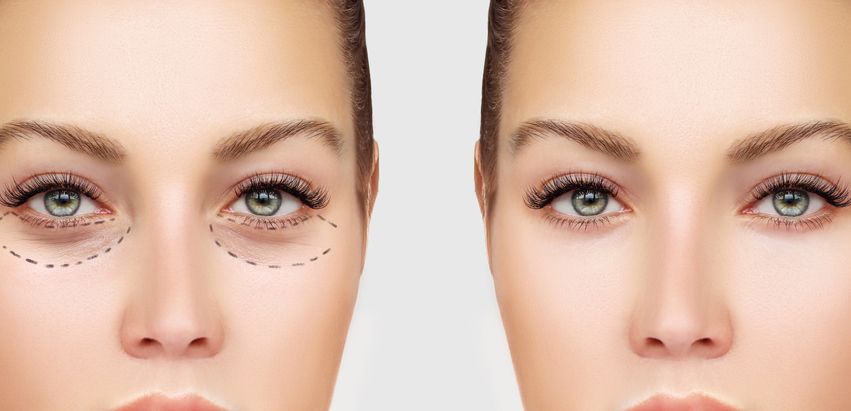
If lifestyle changes and home remedies aren’t enough, medical treatments may offer more lasting results. For some people, chronic puffiness under the eyes is caused by structural changes in the skin, fat, or muscles around the lower eyelids. In these cases, cosmetic procedures or dermatological treatments may be more effective than temporary fixes.
1. Eyelid Surgery (Blepharoplasty)
- Removes or repositions fat and tightens skin
Lower eyelid lift, or lower blepharoplasty, is a surgical procedure that targets eye bags and puffiness caused by fat deposits or weakened muscles. A surgeon removes or redistributes fat and may tighten skin to smooth the area under the eyes. This procedure is done under local anesthetic and is often used when puffiness under the eyes is permanent and not caused by fluid retention.
2. Laser Resurfacing
- Stimulates new collagen growth and tightens skin
Laser resurfacing improves the texture and tone of the delicate eye area. It uses focused light energy to remove damaged skin cells and trigger new collagen growth. This can reduce the appearance of bags under the eyes, dark circles, and fine lines. It's often recommended for people with mild to moderate puffiness or loose skin.
3. Chemical Peel
- Improves skin tone and smoothness
A chemical peel removes the outer layer of skin to encourage the growth of new, smoother skin cells. It can reduce dark circles and improve the appearance of mild under eye puffiness. This treatment is typically done in a clinical setting and may require a short recovery period.
4. Hyaluronic Acid Fillers
- Adds volume and smooths hollow under eye areas
In some cases, puffiness is made worse by volume loss under the eyes. Dermal fillers using hyaluronic acid can fill in these hollows, making under eye bags appear less prominent. Results are temporary, usually lasting around 6 to 12 months, and should only be done by a qualified healthcare professional.
5. Eye Creams and Serums
- Maintains skin health and supports long-term results
Daily use of an eye cream or eye serum with ingredients like caffeine, peptides, or hyaluronic acid can help reduce inflammation and improve skin texture. While not as immediate as cosmetic procedures, these products support the skin’s barrier and may prevent future puffiness.

Treating Puffy Eyes with Miracle Eye Rescue Treatment
If puffy eyes have become a regular part of your mornings, and home remedies just aren’t enough, it may be time to consider a more effective solution. The Miracle Eye Rescue Treatment is a non-invasive option that directly targets common causes of under eye puffiness—like fluid retention, fat buildup, and weakened skin structure—without the need for surgery.
How It Works
This treatment uses triple-wavelength radio frequency (RF) energy combined with red and blue light therapy. The RF energy heats the deeper layers of the skin, helping to improve blood flow and stimulate new collagen growth. This helps to lift and firm the under eye area, reduce swelling, and smooth out fine lines. Meanwhile, the red and blue light work on the surface and middle layers of the skin, helping to dissolve excess fat in the eye bags, clear pigmentation that causes dark circles, and support skin healing.
What Makes It Effective for Under Eye Puffiness
Unlike temporary solutions such as eye creams or cool compresses, the Miracle Eye Rescue Treatment addresses the root causes of puffiness under the eyes. It improves circulation, drains retained water, and reduces fat buildup—all of which contribute to swollen, tired-looking eyes. By promoting collagen production, it also improves skin firmness and texture, helping the eye area look smoother and more rested over time.
Benefits of the Treatment
• Targets multiple issues at once: under eye bags, dark circles, fine lines, and fluid retention
• Non-surgical and low-risk: no needles, no incisions, no downtime
• Safe for most skin types and gentle enough for the delicate eye area
• Quick results with visible improvement after just one session
• Supports long-term skin health through ongoing collagen repair
If you've tried home remedies or eye serums and still wake up with swelling or bags under the eyes, this treatment may offer the results you're looking for. It’s also a good alternative if you're not ready for more invasive cosmetic procedures like eyelid surgery.
Ready to reduce eye puffiness and brighten your under eye area? Book a session of Miracle Eye Rescue Treatment today and get one step closer to firmer, younger looking eyes.
New Beauty's R6 Miracle Eye Rescue TreatmentBook Now to Experience
Miracle Eye Rescue Treatment
1 Minute Self-Registration
Date should not be before minimal date
FAQ
Can Puffy Eyes Be a Sign of an Allergic Reaction to Pillowcases?
Yes, your puffy eyes could definitely be a reaction to allergens in your pillowcase. Dust mites, laundry detergent residue, fabric softeners, or even the fabric itself might trigger an allergic response. You'll want to wash your pillowcases weekly in hot water, try hypoallergenic cases, and switch to fragrance-free detergents. If puffiness persists, consider getting an allergy test to identify specific triggers.
How Long Does Eye Puffiness Typically Last if Left Completely Untreated?
Your eye puffiness typically lasts anywhere from a few hours to 24 hours if you don't treat it. You'll notice the swelling gradually subsiding throughout the day as your body's natural processes work to reduce fluid retention. However, if you're experiencing chronic puffiness that persists beyond 24 hours, you should investigate underlying causes like allergies, diet, or lack of sleep.
Does Sleeping With Contact Lenses Contribute to Morning Eye Puffiness?
Yes, sleeping with contact lenses can definitely contribute to morning eye puffiness. When you wear contacts overnight, you're restricting oxygen flow to your corneas and trapping debris beneath the lenses. This causes your eyes to become irritated and inflamed, leading to that puffy appearance. Your eyes need to breathe freely during sleep, so always remove your contacts before bed to protect your eye health and prevent unnecessary swelling.
Can Certain Medications Make Morning Eye Puffiness Worse Than Usual?
Yes, several medications can intensify your morning eye puffiness. Blood pressure medications, antidepressants, and birth control pills often cause fluid retention that shows up around your eyes. Allergy medications, while helping with symptoms, can sometimes dry out your eyes, leading to inflammation. Don't let this discourage you from taking prescribed meds - instead, talk to your doctor about adjusting timing or exploring alternatives that won't affect your eyes as much.
Is Eye Puffiness Hereditary, or Does It Affect Everyone Equally With Age?
Yes, eye puffiness can be hereditary - if your parents deal with puffy eyes, you're more likely to experience it too. You'll notice that genetics influence how your body stores fat and fluid around your eyes, plus the strength of your skin and muscles in that area. However, everyone faces some degree of eye puffiness with age as skin naturally loses elasticity and muscles weaken over time.
Recommended Articles
COPYRIGHT© NEW BEAUTY MANAGEMENT LIMITED 2025. ALL RIGHT RESERVED.

